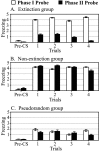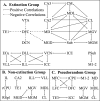Metabolic mapping of mouse brain activity after extinction of a conditioned emotional response
- PMID: 12843278
- PMCID: PMC6741242
- DOI: 10.1523/JNEUROSCI.23-13-05740.2003
Metabolic mapping of mouse brain activity after extinction of a conditioned emotional response
Abstract
Metabolic mapping with fluorodeoxyglucose (FDG), a radiolabeled glucose analog, was used to assess regional activity changes in the mouse brain that result from extinction of a conditioned emotional response (CER). In the extinction group, Pavlovian tone-foot shock conditioning, followed by repeated tone-alone presentations, resulted in the reduction of the CER (freezing behavior). A second group underwent CER acquisition alone (nonextinction group), and a third group showed no CER after pseudorandom training. Then mice were injected with FDG, and tone-evoked brain activity was mapped. In the auditory system, increased activity resulted from the associative effects of acquisition training. Effects common to extinction and nonextinction groups, presumably reflecting the tone-foot shock association independently of CER expression, were found in the medial geniculate, hippocampus, and subiculum. In the extinction group, a major finding was the elevated activity in prefrontal cortex regions. In addition, brain-behavior correlations between FDG uptake and freezing behavior confirmed that subjects with higher prefrontal activity were more successful at inhibiting the CER. Interregional activity correlations showed extensive functional coupling across large-scale networks in the extinction group. The increased activity of the prefrontal cortex and its negative interactions with other regions within the extinction group suggest a functional network inhibiting the CER composed of prefrontal cortex, medial thalamus, auditory, and hippocampal regions. This is the first time that such a functional network resulting from Pavlovian extinction has been demonstrated, and it supports Pavlov's original hypothesis of extinction as the formation of cortical inhibitory circuits, rather than unlearning or reversal of the acquisition process.
Figures




References
-
- Falls WA ( 1998) Extinction: a review of theory and the evidence suggesting that memories are not erased with nonreinforcement. In: Learning and behavior therapy (O'Donohue W, ed), pp 205–229. Boston: Allyn and Bacon.
-
- Fanselow MS ( 1989) The adaptive function of conditioned defensive behavior: an ecological approach to Pavlovian stimulus-substitution theory. In: Ethoexperimental approaches to the study of behavior (Blanchard RJ, Brain PF, Blanchard DC, Parmigiani S, eds), pp 151–166. Boston: Kluwer.
-
- Gewirtz JC, Falls WA, Davis M ( 1997) Normal conditioned inhibition and extinction of freezing and fear-potentiated startle following electrolytic lesions of medial prefrontal cortex in rats. Behav Neurosci 111: 712–726. - PubMed
-
- Goddard GV ( 1964) Functions of the amygdala. Psychol Bull 62: 89–109. - PubMed
-
- Gonzalez-Lima F ( 1992) Brain imaging of auditory learning functions in rats: studies with fluorodeoxyglucose autoradiography and cytochrome oxidase histochemistry. In: Advances in metabolic mapping techniques for brain imaging of behavioral and learning functions (Gonzalez-Lima F, Finkenstädt T, Scheich H, eds), pp 39–109. Boston: Kluwer.
Publication types
MeSH terms
Substances
Grants and funding
LinkOut - more resources
Full Text Sources
